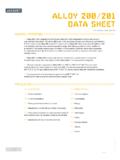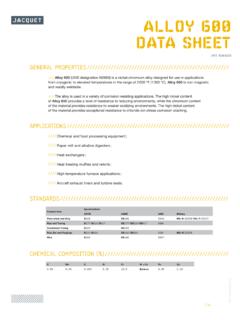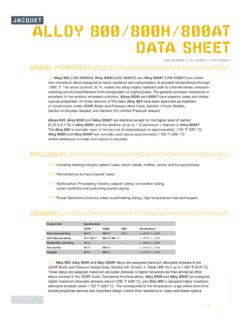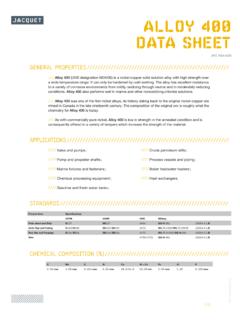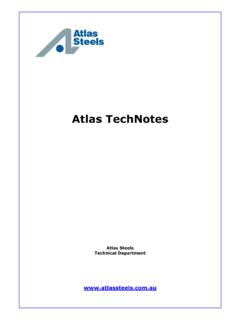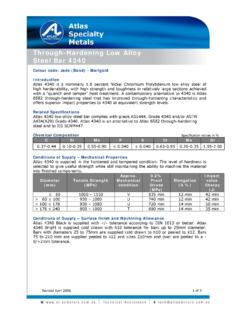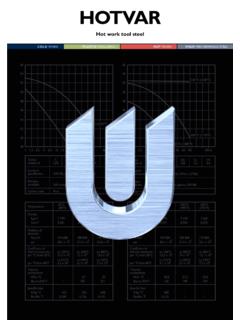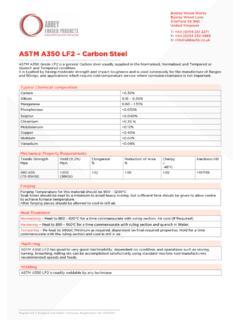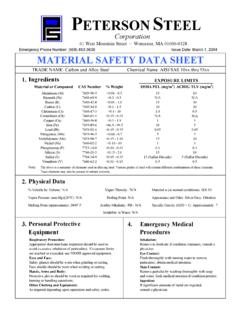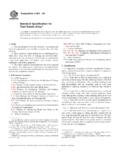Transcription of ALLOY 825 DATA SHEET - Jacquet Metal Service
1 1 / 6 For internal use 825 data SHEETUNS N08825//// ALLOY 825 (UNS designation N08825) is a nickel-chromium ALLOY with additions of molybdenum and copper. It has excellent resistance to both reducing and oxidizing acids, to stress corrosion cracking, and to localized attacks such as pitting and crevice corrosion. ALLOY 825 is especially resistant to sulfuric and phosphoric acids. It offers outstanding performance in Heat Exchangers;//// Evaporators;//// Baffle Plates;//// Pumps;//// Pickling;//// Pickling Hooks;//// Pickling Chains;//// Piping;//// Hopper Bottoms;//// Trays in Electrostatic Precipitators;//// Dampers;//// Wet Scrubber Super Heater Tubing;//// Heat Exchangers;//// Piping;//// Propeller Shafts;//// Engine Exhaust Hydrometallurgy;//// Heat PROPERTIES //////////////////////////////////////// //////////////APPLICATIONS //////////////////////////////////////// ////////////////////////// Piping;//// Valves;//// Expansion Bellows;//// Tank Truck Trailers;//// Scrubbers;//// Condensers;//// Tanks and Vessels;//// Tank and Vessel Linings.
2 //// ChEmICAL PROCESSING INdUSTRy//// PICkLING PROCESSES//// POLLUTION CONTROL//// PULP ANd PAPER//// mUNICIPAL w ASTE INCINERATOR//// mARINE INdUSTRy//// ORE PROdUCTION//// Guide Rails;//// Spray Pipes;//// Racks;//// Stack Gas Reheaters;//// Waste Heat Recovery Exchangers;//// Stack Liners;//// Mixers;//// Agitators;//// Heating Coils;//// Fan Housings;//// Fans;//// Mist / 6 For internal use EmICAL CO mPOSITION //////////////////////////////////////// ///////////mEChANICAL PROPERTIES maxFormYield Strength OffsetUltimate Tensile StrengthElongationksiMPaksiMPa%Plate Annealed493389666245 SHEET Annealed6142111075839 Rod and Bar Annealed4732410069045 Tubing Cold Drawn1298891451 00015 Tubing Annealed6444111277236 STANdARdS //////////////////////////////////////// ////////////////////////Product formSpecificationsASTMASMEDINVdT VBSS heet and plateB424SB42417750432 / 13072 StripB424SB42417750432 / 13073 Smls Pipe and TubingB423SB42317751432 / 23074 Welded Pipe and TubingB163SB163---Rod.
3 BarB425SB42517752432 / 33076 Forgings--17754432 / 3-//// TyPICAL ROOm TEmPERATURE PROPERTIESPhy SICAL PROPERTIES //////////////////////////////////////// /////////////DensityMagnetic PermeabilitySpecific HeatSpecific GravityMelting lb / in3200 oersted Btu / lb- 500-2 550 g / cm3440 J / kg- K1 370-1 400 C3 / 6 For internal use RESISTANCE //////////////////////////////////////// ///////////////CORROSION RESISTANCE //////////////////////////////////////// ///////////TemperatureModulus of ElasticityThermal ConductivityElectric Resistivity F C103 ksikN / mm Btu-in/ft -hr- FW/m- K circ mil / ft 292700-154-21-1271 8321 Energy F ELEvATEd TEmPERATURE PhySICAL PROPERTIES//// ALLOY 825 exhibits outstanding performance in both acids and alkalis in oxidizing as well as reducing environments. The high nickel content gives the ALLOY exceptional resistance to general corrosion, pitting, crevice corrosion, intergranular corrosion as well as stress corrosion cracking.
4 //// ELEvATEd TEmPERATURE PhySICAL PROPERTIES4 / 6 For internal use EnvironmentTemperatureLength of TestCorrosion RateNameTest conditions F CDaysmpymm / ySulfuric Acid40 % Sulfuric Acid40 % Sulfuric Acid60 % Sulfuric Acid60 % Sulfuric Acid80 % Sulfuric Acid80 % AcidAqueous solution containing % Sulfuric Acid12 % Sulfuric Acid pickling solution containing copper sulfate up to %. Immersed inside pickling Acid50 % Sulfuric Acid, 22 % Nitric Acid & 19 % Acid50 % Sulfuric Acid, 22 % Nitric Acid & 19 % Acid45 % Phosphoric Acid75 % Phosphoric Acid75 % Phosphoric Acid75 % Phosphoric Acid20 % H3PO4, 2 % H2SO4, 1 % HF, 40 % H2O plus Acid75-80 % H3PO4, 1 % H2SO4 with some HF. Violent AcidWhite fuming Nitric AcidWhite fuming Nitric AcidInhibited white fuming Nitric AcidInhibited white fuming Nitric AcidInhibited red fuming Nitric AcidInhibited red fuming Nitric Acid5 % Hydrochloric Acid5 % Hydrochloric Acid5 % Hydrochloric Acid10 % Hydrochloric Acid10 % Hydrochloric Acid10 % Hydrochloric Acid20 % Hydrochloric Acid20 % Hydrochloric Acid20 % Hydrochloric AcidConcentrated Hydrochloric AcidConcentrated Hydrochloric Acid15066-1 Acid10 % Acetic Acidboilingboiling5< < % Formic % Lactic % Maleic % Phtalicic Acidboilingboiling5< < % Oxalic Acid Mixture99 % Acetic Acid, < % Acid % acetic acid, % formic acid, % Acid % acetic acid, % formic acid, % potassium permanganate, balance Acid Mixture40 % acetic acid, 6 % propionic acid, 20 % butane, 5 % pentane.
5 8 % ethyl acetate, 5 % methyl ethyl ketone, plus other esters and ELEvATEd TEmPERATURE PhySICAL PROPERTIES5 / 6 For internal use //////////////////////////////////////// ////////////////////////// FORmING//// ALLOY 825 has good ductility and may be readily formed by all conventional methods. Because the ALLOY is stronger than regular steel, it requires more powerful equipment to accomplish forming. Heavy-duty lubricants should be used during cold forming. It is essential to thoroughly clean all traces of lubricants after forming as embrittlement of the ALLOY may occur at high temperatures as a result//// hEAT TREATmENT//// Annealing is done at 1 750 F (954 C) with rapid air hOT wORkING//// Hot working may be done but should be accomplished at temperatures under 1 700 F (927 C) to maintain optimum corrosion resistance of the COLd wORkING//// Cold forming may be done using standard tooling although lain carbon tool steels are not recommended as they tend to produce galling.
6 Soft die materials (bronze, zinc alloys , etc.) minimize galling and produce good finishes, but die life is somewhat short. For long production runs, the ALLOY tool steels, (D-2, D-3) and high-speed steels (T-1, M-2, M-10) give good results, especially if hard chromium plated to reduce galling. Tooling should be such as to allow for liberal clearances and radii. Heavy duty lubricants should be used to minimize galling in all forming operations. Bending of SHEET or plate through 180 is generally limited to a bend radius of 1 T for material up to .1 250 thick ( mm) and 2 T for material thicker than .1 250 ( mm).//// hARdENING//// ALLOY 825 is hardened by cold work wELdING//// The commonly used welding methods work well with ALLOY 825. Matching ALLOY filler Metal should be used. If matching ALLOY is not available, then the nearest ALLOY richer in the essential chemistry, (Ni, Co, Cr, and Mo) should be used.
7 All weld beads should be slightly It is not necessary to preheat. Surfaces to be welded must be clean from oil, paint or crayon markings and any residual lubricants used in the forming process. The cleaned area should extend at least 2 ( mm) beyond either side of a weld joint. //// Gas Tungsten Arc Welding: DC straight polarity (electrode negative) is recommended. Keep as short an arc length as possible and use care to keep the hot end of filler Metal always within the protective / 6 For internal use Shielded Metal Arc Welding: Electrodes should be kept in dry storage and if moisture has been picked up the electrodes should be baked at 600 F (316 C) for one hour to insure dryness. Current settings vary from 60 amps for thin material ( thick) up to 140 amps for material of thick and heavier. It is best to weave the electrode slightly as this ALLOY weld Metal does not tend to spread.
8 Cleaning of slag is done with a wire brush (hand or powered). Complete removal of all slag is very important before successive weld passes and also after final Gas Metal Arc Welding: Reverse-polarity DC should be used and best results are obtained with the welding gun at 90 degrees to the joint. For Short-Circuiting-Transfer GMAW, a typical voltage is 20-23 with a current of 110-130 amps and a wire feed of 250-275 inches per minute (635-698 mm). For Spray-Transfer GMAW, voltage of 25 to 33 and current in the range of 175-300 amps with wire feed rate of 200-350" per minute (508-889 mm) are Submerged Arc Welding: Matching filler Metal , the same as for GMAW, should be used. DC current either reverse or straight polarity may be used. Convex weld beads are mAChINING//// Conventional machining techniques for iron based alloys may be used on ALLOY 825.
9 This ALLOY does work-harden during machining. //// Heavy duty machining equipment and tooling should be used to minimize chatter or work-hardening of the ALLOY ahead of the cutting. Most any commercial coolant may be used in the machining operations. Water-base coolants are preferred for high speed operations such as turning, grinding, or milling. Heavy lubricants work best for drilling, tapping, broaching or boring. //// Turning: Carbide tools are recommended for turning with a continuous cut. High-speed steel tooling should be used for interrupted cuts and for smooth finishing to close tolerance. Tools should have a positive rake angle. //// For drilling, steady feed rates must be used to avoid work hardening due to dwelling of the drill on the Metal . Rigid set-ups are essential with as short a stub drill as feasible. Heavy-duty, high-speed drills with a heavy web are recommended.
10 //// For milling, to obtain good accuracy and a smooth finish it is essential to have rigid machines and fixtures and sharp cutting tools. High-speed cutters such as M-2 or M-10 work best with cutting speeds of 30-40 feet per minute (914-1 220 cm) and feed of (. mm) per cutting For grinding, the ALLOY should be wet ground and aluminum oxide wheels or belts are preferred.
